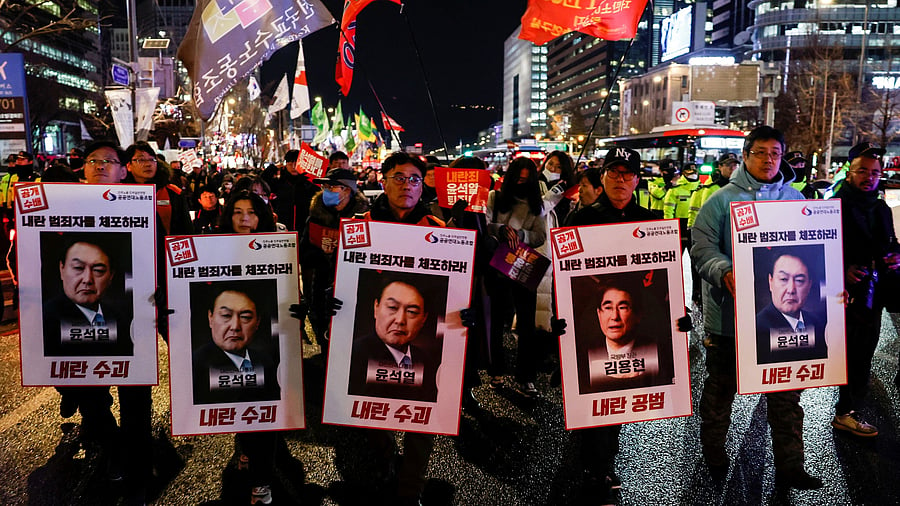
People protest during a candlelight vigil calling for the resignation of South Korean President Yoon Suk Yeol, in Seoul
Credit: Reuters photo
The silence sucked the sound out of the world, writes Han Kang, South Korea’s Nobel Prize-winning author, in her book Human Acts (2014). In her works, as in many aspects of her country’s political culture, silence is not absence — it is alive, dense and throbbing — a memorial to dissent and a stillness that carries within it a powerful, almost sacred force.
Albert Kwon, a 30-something South Korean who works at Nami Island, a tourist destination two hours away from the capital, Seoul, puts it more matter-of-factly. “Silence is good — you notice it faster.”
There is the South Korea of skyscrapers, snazzy cars, soapy dramas and K-pop anthems, and there is another, a quieter world. Silent demonstrations are a South Korean tradition that have often had a louder impact than any chanting crowds or violent mobs. They have contoured the country’s hard-earned democracy. Sociologists believe this is a silence born out of anger and grief against the extreme bloodshed and violence that marked the 1980 Gwangju Uprisings, in which the citizens of Gwangju in the southwest rose against the military junta. Hundreds (some believe thousands) were killed mercilessly — an incident that seems to have left a deep scar on the nation’s psyche.
Take the most recent instance. Last December, after President Yoon Suk Yeol controversially declared martial law, South Koreans across the country gathered in public squares. No teargas was employed; no stones were thrown, and no barricades were stormed. The older generation clutched candles; some got their tealights complete with hand warmers, while the younger, who participated in huge numbers, held up their mobile flashlights, yes, just like in K-pop concerts. In fact, there were music performances woven into the protests that were otherwise determinedly silent. And it worked like it has before. The President was impeached by the National Assembly and formally removed from office in April this year. Fresh elections are scheduled for June 3.
There are older, more poignant precedents. In what is now known as the Candlelight Revolution, South Koreans took to the streets in 2016 against President Park Geun-Hye, following allegations of corruption. Families attended, singing songs and holding candles, giving the protests an almost prayer-like ambience. Park was eventually impeached, marking a turning point in the country’s democracy.
Women and youth have been at the forefront of this legacy of resistance. Busy caricaturing the South Korean youth for their tech-savvy flakiness, the world has not noticed their other side. During the ‘No-Japan’ silent boycott in 2019, sparked by trade and labour tensions, young Koreans refused to travel to Japan or buy Japanese products. Interestingly, this protest was organised online and reflected in a sharp decline in sales for Japanese companies in South Korea. More recently, Korean students have been staging silent ‘die-ins’ (lying on the ground to indicate symbolic death) on college campuses against global climate inaction.
In October 2016, women dressed in black gathered in large numbers in Gwanghwamun Square, Seoul’s most famous plaza. They stood still, holding placards that said, ‘My Body, My Choice’. This was to protest against a proposed bill that aimed to curb abortion. Eventually, in 2019, the Constitutional Court struck down the abortion ban.
Every Wednesday since January 8, 1992, ‘comfort women’, the survivors of Japan’s World War II sexual slavery system, have held silent protests outside the Japanese embassy in Seoul. Wearing traditional hanbok, they sit silently holding signs. Several are now in their 90s, and many more are dead. But those alive come without fail, making this one of the world’s longest-running protests.
Part of the reason for the silence to resonate so deeply is cultural. Confucian values of restraint and harmony are still very much a part of the country’s everyday fabric, and a deeply ingrained distaste for loud confrontations is obvious even in minimal social interactions. Writers like Han Kang have spoken about how, historically, silent protests became a safer, more practical way to confront authority in a democracy, fledgling under the shadow of brutal martial crackdowns and a lingering fear of censorship and state violence. It is difficult to prosecute someone standing still, is it not? And as Kwon said, in a world overwhelmed by noise, silence is starkly noticeable — a radical choice.
However, there seems to be a curious dichotomy in how young Koreans react to any casual talk about the country’s politics. Despite their apparent political awareness, many brush the topic off or are reluctant to continue the conversation. This collective feeling stems from frustration at the lack of transparency and brazen corruption, feels Kyung Hyuk Minn, CEO of Nami Island. “South Korea — culture, food, music, thumbs up; politics, thumbs down.”
(The writer was in South Korea recently on the invitation of Nami Island Arts & Education, Inc)